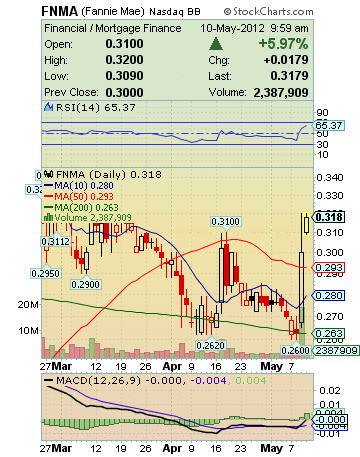 Don’t look now but shares in U.S. mortgage giant Federal National Mortgage Association, Fannie Mae (OTCBB: FNMA), are smoking hot. FNMA reported Q1 results, its first net income gain since the government took them over during the 2008 financial crisis. Does this mean that shares in the penny stock could quickly return to their $86 level they had at the turn of the century?
Don’t look now but shares in U.S. mortgage giant Federal National Mortgage Association, Fannie Mae (OTCBB: FNMA), are smoking hot. FNMA reported Q1 results, its first net income gain since the government took them over during the 2008 financial crisis. Does this mean that shares in the penny stock could quickly return to their $86 level they had at the turn of the century?
Fannie Mae reported $2.7 billion of net income attributable to common stockholders for Q1 and that, rather than seek additional financial aid from taxpayers, they will pay a dividend of $2.8 billion to the U.S. Treasury Department. That’s one hell of a dividend payment.
![]() Looking for Hot Penny Stocks?
Looking for Hot Penny Stocks?
Click here and get Alerts on Penny Stock Picks FREE.
 FNMA Stock Chart:
FNMA Stock Chart:
Market Cap (intraday): 1.82B
Enterprise Value (May 10, 2012): 3.05T
52-Week High
(Feb 17, 2012): 0.41
52-Week Low
(Dec 22, 2011): 0.19
50-Day Moving Average: 0.29
200-Day Moving Average: 0.26
Avg Vol (3 month): 4,478,620
Avg Vol (10 day): 3,679,600
Shares Outstanding: 5.74B
Float: 5.74B
When you compare the $2.7 Billion net income with the same quarter a year ago, a net loss of $6.5 billion, it’s a $9.2 billion turn around. What’s even more exciting is that their biggest rival, Freddie Mac, is naming former head of E*Trade Financial Corp., Donald Layton, as its new CEO which should encourage Michael Williams, president and CEO of Fannie Mae, to step up the Company’s game after such a great quarter.
Fannie Mae reported $5.57 billion in Q1 revenues compared to $5.2 billion for the same period last year. The major difference between last year’s Q1 loss and this years net income was the provision for credit losses; $8,554 billion. Basically, when a loan is uncollectible, typically upon foreclosure, the Company records a charge-off; provision for credit losses.
Fact: IF you invested $1,000 in February, 1982 when FNMA stock was trading at $5.25, roughly 190 shares, and held it until December, 2000 when the stock reached $86.75, the following would have occurred:
• You would have received 3 shares for every one share you owned on October 17, 1989,
• You would have received 4 shares for every one share you owned on January 16, 1996,
• You would have received a dividend payment every quarter as high as $0.28 per share (October 27, 2000),
When you sold your original $1,000 investment, or 190 pre-stock-split shares, now 2,280 shares, at the December,2000 high of $86.75, you just cashed a check for $197,790. A gain of roughly 17,000% plus dividend payments.
About FNMA:
Fannie Mae is a government-sponsored enterprise (“GSE”) that was chartered by Congress in 1938. The public mission of FNMA is to support liquidity and stability in the secondary mortgage market, where existing mortgage-related assets are purchased and sold, and increase the supply of affordable housing.
The Company charter does not permit them to originate loans and lend money directly to consumers in the primary mortgage market. Their most significant activity is securitizing mortgage loans originated by lenders into Fannie Mae mortgage-backed securities that the Company guarantees, which they refer to as Fannie Mae MBS.
FNMA also purchases mortgage loans and mortgage-related securities for their mortgage portfolio. The Company uses the term “acquire” in its reports to refer to both their guarantees and their purchases of mortgage loans. The Company obtains funds to support their ongoing business activities by issuing a variety of debt securities in the domestic and international capital markets.
FNMA is a corporation chartered by the U.S. Congress. The Company’s conservator, FHFA, is a U.S. government agency. Treasury owns the Company’s senior preferred stock and a warrant to purchase 79.9% of their common stock which trades under the symbol FNMA on the OTC Bulletin Board.
Furthermore, Treasury has made a commitment under a senior preferred stock purchase agreement to provide the Company with funds under specified conditions and, after 2012, up to a maximum amount, to maintain a positive net worth. The U.S. government does not guarantee FNMA securities or other obligations.
You can view the FNMA 10-Q on the SEC website by clicking here, or on Fannie Mae’s Web site address is www.fanniemae.com
Bottom Line: The penny stock of FNMA could make you millions at its current level if you have a year or so to sit on the stock and if the housing market continues to improve. Two things Americans need are food and a place to live. Does it mean FNMA is a good penny stock to buy? Got $1,000 and a year or so to wait?

Here is your opportunity to subscribe to the Most Read Penny Stock Newsletter
If You Can’t Make Money With Us, You Shouldn’t Be Trading Penny Stocks
(We are 100% Anti-Spam and will never rent or sell your information)
ShareMAY

